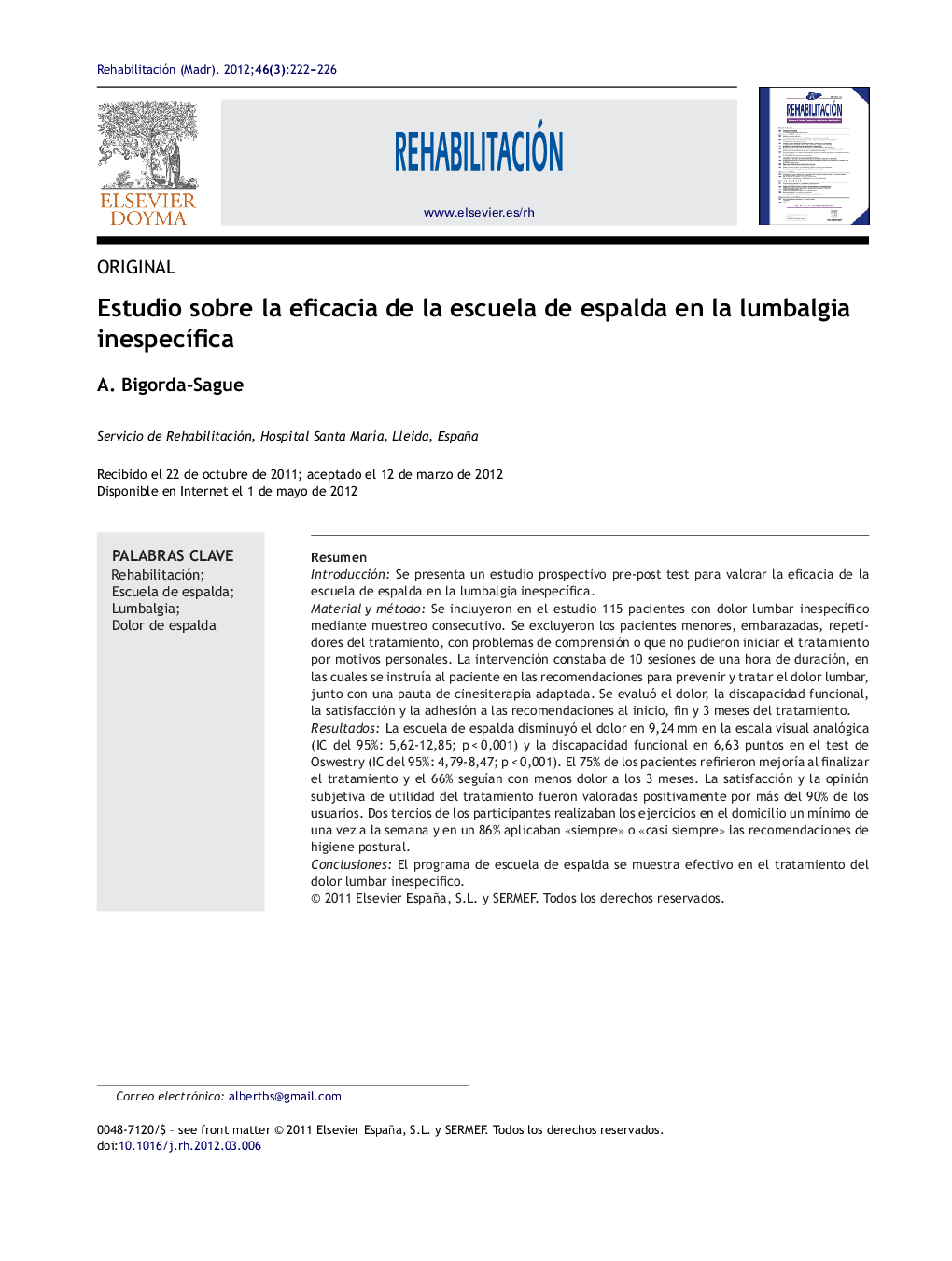| Article ID | Journal | Published Year | Pages | File Type |
|---|---|---|---|---|
| 4084908 | Rehabilitación | 2012 | 5 Pages |
ResumenIntroducciónSe presenta un estudio prospectivo pre-post test para valorar la eficacia de la escuela de espalda en la lumbalgia inespecífica.Material y métodoSe incluyeron en el estudio 115 pacientes con dolor lumbar inespecífico mediante muestreo consecutivo. Se excluyeron los pacientes menores, embarazadas, repetidores del tratamiento, con problemas de comprensión o que no pudieron iniciar el tratamiento por motivos personales. La intervención constaba de 10 sesiones de una hora de duración, en las cuales se instruía al paciente en las recomendaciones para prevenir y tratar el dolor lumbar, junto con una pauta de cinesiterapia adaptada. Se evaluó el dolor, la discapacidad funcional, la satisfacción y la adhesión a las recomendaciones al inicio, fin y 3 meses del tratamiento.ResultadosLa escuela de espalda disminuyó el dolor en 9,24 mm en la escala visual analógica (IC del 95%: 5,62-12,85; p < 0,001) y la discapacidad funcional en 6,63 puntos en el test de Oswestry (IC del 95%: 4,79-8,47; p < 0,001). El 75% de los pacientes refirieron mejoría al finalizar el tratamiento y el 66% seguían con menos dolor a los 3 meses. La satisfacción y la opinión subjetiva de utilidad del tratamiento fueron valoradas positivamente por más del 90% de los usuarios. Dos tercios de los participantes realizaban los ejercicios en el domicilio un mínimo de una vez a la semana y en un 86% aplicaban «siempre» o «casi siempre» las recomendaciones de higiene postural.ConclusionesEl programa de escuela de espalda se muestra efectivo en el tratamiento del dolor lumbar inespecífico.
IntroductionA prospective study on pre-post test to assess the effectiveness of the back school in non-specific low back pain is presented.Material and methodsThe study included 115 patients with non-specific low back pain using consecutive sampling. Exclusion criteria were patients under 18 years old, pregnant women, patients who had already repeated the same therapy, people with problems of comprehension or those who could not start the treatment for personal reasons. The intervention consisted of ten one-hour sessions in which the patient was instructed on the recommendations to prevent and treat back pain with a tailored exercise therapy program. Pain, functional disability, satisfaction and adherence to the recommendations were assessed at the beginning, at the end of treatment and three months later.ResultsBack school reduced pain in 9.24 mm on the Visual Analogue Scale (95% CI: 5.62-12.85; P<.001) and functional disability 6.63 points on the Oswestry test (95% CI: 4.79-8.47; P<.001). Improvement after the treatment was reported by 75% of patients and 66% had with less pain at 3 months. Satisfaction and subjective opinion of usefulness of treatment were rated positively by over 90% of users. Two thirds of the participants performed the exercises at home at least once a week and 86% «always» or «very often» applied postural hygiene recommendations.ConclusionsThe back school program proves effective in treating non-specific low back pain.
